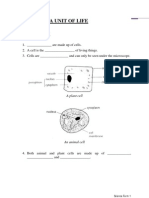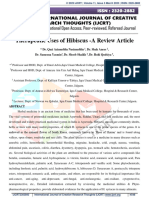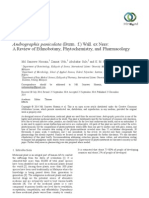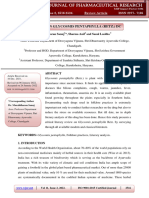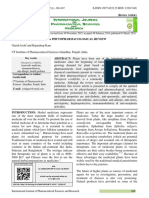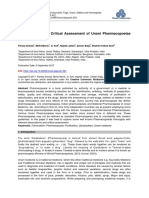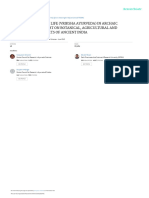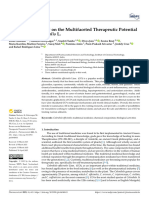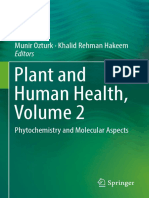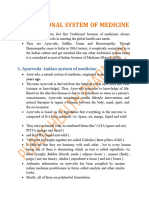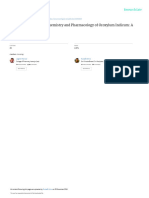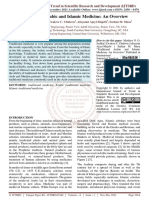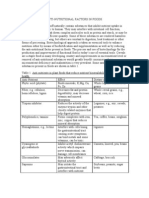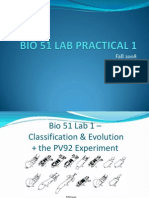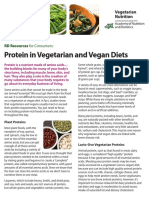Herbal in Quran
Herbal in Quran
Uploaded by
Husna Maulidia SCopyright:
Available Formats
Herbal in Quran
Herbal in Quran
Uploaded by
Husna Maulidia SCopyright
Available Formats
Share this document
Did you find this document useful?
Is this content inappropriate?
Copyright:
Available Formats
Herbal in Quran
Herbal in Quran
Uploaded by
Husna Maulidia SCopyright:
Available Formats
See discussions, stats, and author profiles for this publication at: https://www.researchgate.
net/publication/281200399
PLANTS IN THE HOLY QURAN: A LOOK
Article in WORLD JOURNAL OF PHARMACY AND PHARMACEUTICAL SCIENCES · July 2015
CITATIONS READS
0 824
2 authors:
Darakhsa Sheikh Ashwini Kumar Dixit
Guru Ghasidas University Guru Ghasidas University
2 PUBLICATIONS 0 CITATIONS 47 PUBLICATIONS 82 CITATIONS
SEE PROFILE SEE PROFILE
Some of the authors of this publication are also working on these related projects:
Hedychium project View project
Invasive plants View project
All content following this page was uploaded by Ashwini Kumar Dixit on 20 August 2016.
The user has requested enhancement of the downloaded file.
WORLD JOURNAL OF PHARMACY AND PHARMACEUTICAL SCIENCES
Dixit et al. World Journal of Pharmacy and Pharmaceutical Sciences
SJIF Impact Factor 5.210
Volume 4, Issue 08, 715-738. Research Article ISSN 2278 – 4357
PLANTS IN THE HOLY QURAN: A LOOK
Darakhsa Kauser Sheikh and Ashwini Kumar Dixit*
Department of Botany, Guru Ghasidas Central University, Koni, Bilaspur CG India-495009.
Article Received on ABSTRACT
17 May 2015,
Islam is the most complete religion, which presents the elasticity to
Revised on 10 June 2015, respond new technologies and a complete way for living. In Islam,
Accepted on 02 July 2015
ethical teachings of biomedical ethics are linked with Holy Quran and
Prophet Muhammad (PBUH).The present study is a part of check list
*Correspondence for
of medicinal plants and their uses enlisted in Holy Quran.
Author
Ashwini Kumar Dixit Approximately 19 Plant species belongs to 18 families were reported,
Department of Botany, having unique medicinal properties, chemical constitution, and their
Guru Ghasdas Central distribution pattern in the world. This study also described a wide
University, Koni, Bilaspur
range of plants mentioned in the Holy Quran to symbolize holy plants
CG India-490059.
such as fig, olive, date palm, and pomegranate or aroma plant such as
zinger, basil and camphor or nutritious plant such as onion garlic and lentils. This study can
be accepted to document the medicinal use of plants for the human welfare.
KEYWORDS: Quran, Medicinal properties, Chemical constituents.
INTRODUCTION
1400 years old, the holy Quran is the word of God as transmitted by the angel Gabrielle, in
the Arabic language through Prophet Mohammed. The religious book is actually available in
many languages and divided into 114 surahs, or chapters and the surahs are conventionally
assigned to two broad categories: those revealed at Mecca or Madina. All the surahs are
divided into ayahs or verses. The surahs themselves vary in length, ranging from the longest
surah 2, with 282 verses, to the three shortest (surahs 103,108 and 110) each of which has
only three verses. With some exceptions, the surahs are arranged in the Quran in descending
order of length, with the longest at the beginning and the shortest at the end. The Quran as a
whole is divided into thirty parts, which in turn are divided into short divisions of nearly
equal length, to facilitate study and memorization.
www.wjpps.com Vol 4, Issue 08, 2015. 715
Dixit et al. World Journal of Pharmacy and Pharmaceutical Sciences
The Quran reveals the secrets of critical scientific issues such as the big bang model of the
origin of the universe, the theory of the expansion of the universe, gaseous state of the
universe, celestial bodies tied to orbits, the existence of sun’s orbit, the rounded shape of the
earth, the reduction of matter from the earth’s edages, the fact that the earth and the moon are
moving each in its own path, the fact that the light from the moon is a mere reflection of the
light from the sun, the critical positioning of the stars, the fact that the mountains are
considered as a wedge for the Earth, human exploration of space, the protection of the earth
by the atmosphere from bombardment by meteorites, various aspects of embryology
(including the development of babies in a mother’s womb and that the amnion consists of
three layers), gender determination, existence of pairs in all creations (Buacaille, 1987).
In Islam diseases are cured in two ways, first the cure of soul through prayers and second the
cure of ailments through medicines. Islamic medicine initiated from Hazrat Adam (Alaihe
Salaam.) and was completed at Hazrat Muhammad (Sallallaho Alaihe Wasallaam) but
explore and compiling of these medicine is still continued after the death of Holy Prophet
Muhammad (Sallallaho Alaihe Wasallaam) throughout the world (Ahmad et al. 2009; Yari et
al. 2011). Al-Quran is one of the best reference books describing the importance of plants in
different Surahs as in Al-Momeenoon, Al-Rehman, Al-Bakra and Al-Inaam. Our Holy
Prophet (Sallallaho Alaihe Wasilla) used and recommended medicinal plants for various
diseases and food (Naser 1976).
Plants are an essential component of the universe. Human beings have used plants as
medicines from the very beginning of time. Plants have always been an exemplary source of
drugs and many of the currently available drugs have been derived directly or indirectly from
them (Al-Quran, 2008). This encouraged us to check list of medicinal flora and their uses
enlisted in Holy Quran.
MATERIALS AND METHODS
The present research work was performed by reviewing the Holy Quran. Comprehensive and
detailed information about plants were collected from the Ayat and Suras of Holy Quran.
Plants species were arranged in systematic order of botanical names in alphabetic order
followed by Arabic name, English name, Hindi name, Family, Distribution, Part used,
Chemical constituents, Medicinal properties and references cited from Holy Quran.
www.wjpps.com Vol 4, Issue 08, 2015. 716
Dixit et al. World Journal of Pharmacy and Pharmaceutical Sciences
RESULTS
Below mentioned the plants description with their chemical constituents and medicinal uses
of plants listed in Quran
1. Alhagi Maurorum Medik.
Arabic name-Turanjabin, Kazanjbin
English name-Caspian manna, Persian Manna plant
Hindi name-Kshiri
Family- Fabaceae
Distribution-Cultivated in India, Afghanistan, Azerbaijan, northwest China, Iran, Iraq, Israel,
Jordan, Kazakhstan, Kuwait, Lebanon, Pakistan Syria and Russia.
Part used - Flowers, leaves and roots.
Chemical constituent-Flavonoids, fatty acids, coumarins, sterols, vitamins, alkaloids,
carbohydrates, tannins, unsaturated sterols, triterpenes, flavanone and glycosides.
Medicinal uses - Used in rheumatic pains‚ bilharzias‚ liver and urinary tract inflammation
and also used for various types of gastrointestinal discomforts. These plant are proved to
have antidiarrhoeal activity and induce relaxation of the smooth muscle and antinociceptive
effect. Its flowers are used to treat piles, migraine, and warts. Oil from the leaves is used in
the treatment of rheumatism. Locally, water extracts of its roots are used to enlarge the ureter
and to remove kidney stones.
References from Quran
Surah 2. Al-Baqara, Ayah 57
And We shaded you with clouds and sent down on you Al- Manna and the quails, (saying):
“Eat of the good lawful things We have provided for you,” (but they rebelled). And they did
not wrong Us but they wronged themselves.
Surah 7. Al-A'raf, Ayah 160
And We divided them into twelve tribes (as distinct) when his people asked him for water
(saying): “Strike the stone with your stick”, and there gushed forth out of it twelve springs,
each group knew its own place for water. We shaded them with the clouds and sent down
upon them Al-Manna and the quails (saying): “Eat of the good things with which provided
you.” They harmed Us not but they used to harm themselves
www.wjpps.com Vol 4, Issue 08, 2015. 717
Dixit et al. World Journal of Pharmacy and Pharmaceutical Sciences
Surah 20.Ta-ha, Ayah 80.
O children of Israel! We delivered you from your enemy, and We made a covenant with you
on the right side of the Mount, and We sent down to you Al-Manna and quails.
2. Allium cepaL.
Arabic name - Basal
English name - Onion
Hindi name - Pyaj
Family - Liliaceae
Distribution - India, Pakistan, China, Russia, America and Europe
Part used - Rhizome, leaves and seeds.
Chemical constituent - Bulbs contain volatile oil with sulphurous constituents, including
allylpropydisulphide, allicin, allin, flavonoids, phenolic acids, sterols, diphenylamine,
protein, carbohydrates, calcium, iron and vitamins A,B,C.
Medicinal uses– Plant used in Pungent, antimicrobial, inflammation, fattening, aphrodisiac
dental carries baldness, feckless, eczema, moles, urinary discharges, acrid, sweet aromatic,
emollient, emmenagogue, expectorant, carminative, diuretic, anodyne, tonic, stomatitis,
appetizer, anti-ageing rejuvenate, flatulence, bronchitis, spleenomegaly, heptomegaly,
pneumopathy, opthalmia, vomiting, otalagia, phyringodynia, malaria, lumbago, epilepsy,
tumors, wounds, paralysis, arthralgia and leukoderma.
References from Holy Quran
Surah 2.Al-Baqara, Ayah 61.
And (remember) when you said, “O Musa (Moses)! We cannot endure one kind of food. So
invoke your lord for us to bring forth for us of what the earth grows, its herbs, its cucumbers.
Its fum (wheat or garlic), its lentils and its onion.” He said, "Would you exchange that which
is better for that which is lower? Go you down to any town and you shall find what you
want!” And they were covered with humiliation and misery, and they drew on themselves the
Wrath of Allah That was because they used to disbelieve the Ayat (proofs, evidences, verses,
lessons, signs, revelations etc.) of Allah and killed the Prophets wrongfully. That was because
they disobeyed and used to transgress the bounds (in their disobedience to Allah, i.e. commit
crimes and sins).
www.wjpps.com Vol 4, Issue 08, 2015. 718
Dixit et al. World Journal of Pharmacy and Pharmaceutical Sciences
3. Allium sativum L.
Arabic name - Soom
English name - Garlic
Hindi name - Lahson
Family - Alliaceae
Distribution - Cultivated throughout Egypt, Italy, France, India, Pakistan, China and USA.
Part used – Bulb
Chemical constituent- Cordinine A and B, saponins, allicin, allylprophyldisulphide,
glucosides of kaempferol and quercitin, sterols and hydrocarbons. It also contain starch
mucillagenous matter, albumin, calcium, iron, and vitamin –C. it also contain some volatile
oil.
Medicinal uses – Used in anthelmintic, hypertension, stimulant, gastritis, antiseptic,
antimicrobial.
References from Holy Quran
Surah 2.Al-Baqara, Ayah 61.
And (remember) when you said, “O Musa (Moses)! We cannot endure one kind of food. So
invoke your lord for us to bring forth for us of what the earth grows, its herbs, its cucumbers.
Its fum (wheat or garlic), its lentils and its onion.” He said, "Would you exchange that which
is better for that which is lower? Go you down to any town and you shall find what you
want!” And they were covered with humiliation and misery, and they drew on themselves the
Wrath of Allah That was because they used to disbelieve the Ayat (proofs, evidences, verses,
lessons, signs, revelations etc.) of Allah and killed the Prophets wrongfully. That was because
they disobeyed and used to transgress the bounds (in their disobedience to Allah, i.e. commit
crimes and sins).
4. Brassica nigra (L.) Koch.
Arabic name - Khardal
English name - Black mustard
Hindi name- Rai
Family- Brassicaceae
Distribution- Cultivated throughout india.
Part used - Leaves, seeds.
www.wjpps.com Vol 4, Issue 08, 2015. 719
Dixit et al. World Journal of Pharmacy and Pharmaceutical Sciences
Chemical constituent - Seed contains: glucoside, singirin, sinapine and A volatile
Isothiocyanate and essential oil.
Medicinal uses -Anthemitic, appetizer, cough, enlargement of spleen, itching, skin disease,
tumors, rheumatism.
References from Quran
Surah 21. Al-Anbiyaa, Ayah 47
And We shall set up balances of justice on the Day of Resurrection, then none will be dealt
with unjustly in anything. And if there be the weight of a mustard seed, We will bring it. And
Sufficient are We to take account.
Surah 31. Luqman, Ayah 16.
“O my son! If it be (anything) equal to the weight of a grain of mustard seed, and though it be
in a rock, or in the heavens or in the earth, Allah will bring it forth. Verily, Allah is Subtle (in
bringing out that grain), Well-Aware (of its place).
5. Cinnamomum comphora (L.) presl
Arabic name-Kafoor
English name- Camphor tree
Hindi name- Kapur
Family- Lauraceae
Distribution- Cultivated in India, Srilanka, Japan and china.
Part used- Leaves and branches.
Chemical constitution - Essential oil sesquiterpenes, comphorenone,compherenol
Roots contain: Alkaloids, laurolistsine, reticuline.
Leaves contain: palmitone.
Heartwood contain: cyclopentenone.
Medicinal uses -Used in bronchial asthma, hysteria, satyriasis, nocturnal emission,
spermatorrhea, scorpion strings, colic, diarrhea, dysentery, nausea, vomiting.
www.wjpps.com Vol 4, Issue 08, 2015. 720
Dixit et al. World Journal of Pharmacy and Pharmaceutical Sciences
References from Quran
Surah 76. Ad-Dahr, Ayah 5-6.
5. Verily, the Abrar (the pious and righteous), shall drink of a cup (of wine) mixed with
(water from a spring in paradise called) Kafur.
6. A spring wherefrom the salves of Allah will drink, causing it to gush forth abundantly.
6. Cucumis sativus L.
Arabic name - Qissa, Khiarun
English name - Cucumber
Hindi name - Khira kakari
Family - Cucurbitaceae
Distribution - Cultivated throughout the tropical and sub-tropical countries of the world.
Part used- Fruits
Chemical constituent - Fruit contain rutin.
Seeds contain glucosides including cucurbitaside.
Leaves contain free cucurbitasides B and C, ferrodoxin, alpha-apinasterol.
Flowers contain free and bound sterols, also proteolic enzymes, ascorbic acid oxidase, and
succinic and malic dehydrogenase.
Medicinal uses– Plant used in the treatmentof haemostatic, diuretic, purgative, refrigerant,
nutritive antipyretic, Bronchitis , burning sensation, fever, general debility, haemorrhages,
insomnia, jaundice, strangury, constipation, renal calculus.
Quranic References
Surah 2.Al-Baqara, Ayah 61.
And (remember) when you said, “O Musa (Moses)! We cannot endure one kind of food. So
invoke your lord for us to bring forth for us of what the earth grows, its herbs, its cucumbers.
Its fum (wheat or garlic), its lentils and its onion.” He said, "Would you exchange that which
is better for that which is lower? Go you down to any town and you shall find what you
want!” And they were covered with humiliation and misery, and they drew on themselves the
Wrath of Allah That was because they used to disbelieve the Ayat (proofs, evidences, verses,
lessons, signs, revelations etc.) of Allah and killed the Prophets wrongfully. That was because
they disobeyed and used to transgress the bounds (in their disobedience to Allah, i.e. commit
crimes and sins).
www.wjpps.com Vol 4, Issue 08, 2015. 721
Dixit et al. World Journal of Pharmacy and Pharmaceutical Sciences
7. Ficus carica L.
Arabic name- Teen
English name - Fig
Hindi name - Anjeera
Family - Moraceae
Distribution- Mediterranean Region and S.W.Asia: Afghanistan, Pakistan and India.
Part used - leaves, root and fruits
Chemical constituent - Fig contain 43- 62 % fruit sugar, manily invert sugar, flavonoids,
vitamins A,,B,C and D ,iron, phosphorous, calcium, ficin, and enzymes.
Medicinal uses -The root is tonic, useful in leucoderma and ringworm. The fruit is sweet,
antipyretic, tonic, purgative useful in inflammation, weakness, paralysis, thirst “Vatta
diseases” of head, diseases of liver and spleen, pain in chest, cures piles, stimulate growth of
hair. The milky juice is expectorant, diuretic, and dangerous for eye. Fig latex is used as an
anthelmintic.The Ficus carica leaf has been reported hypoglycaemic, hepatoprotective and
latex reported the anthelmintic activity, anti-inflammatory, antipyretic activity.
References from Quran
Surah 95. At-Tin, Ayah 1-8.
1. By the fig, and the olive.
2. By Mount Sinai.
3. By this city of security (Makkah).
4. Verily, We created man in the best stature (mould).
5. Then We reduced him to the lowest of the low, shall have a reward without end
(Paradise).
6. Save those who believe (in Islamic Monotheism) and do righteous deeds. Then they
7. Then what (or who) causes you (O disbelivers) to deny the Recompense (i.e. the Day
of Resurrection)?
8. Is not Allah the Best Of judges?
8. Lagenaria siceraria(Mol.) Standely.
Arabic name- Yakteen, Daba
English name - Bitter bottle gourd
Hindi name- Kadvilauki
www.wjpps.com Vol 4, Issue 08, 2015. 722
Dixit et al. World Journal of Pharmacy and Pharmaceutical Sciences
Family name - Cucurbitaceae
Distribution- Found all over the world.
Part used- Seed, leaves, flower, roots, fruits,
Chemical constitution - Fruits pectin, cucurbitacins, triterpenoides.
Seeds - Rhamnose, glucose, fructose, galactose, sucrose, raffinose, stachyose.
Seed oil - saponin, fatty oil, palmitic, palmitoliec, oleic, stearic & linoleic acids.
Medicinal properties - Anti-inflammatory, emetic, purgative, anodyne, depurative,
expectorant, febrifuge, refrigerant, diuretic, acrid, Brain tonic,Piles, dental carries, cracked
heel, retained placenta, jaundice.
References from Holy Quran
Surah 37. As-Saaffat, Ayah 146.
146. And We caused a plant of gourd to grove over him.
9. Lens culinaris Med.
Arabic name - Adas
English name - Lentil
Hindi name - Masur
Family - Papilionaceae
Distribution - Cultivated throughout the colder parts of India
Part used – Seeds
Chemical constituents -Seeds contain – proteins, vitamin-B, tricetin, luteolin, kaempferol,
glycoside, 3,4,7 –trihydroxyflavone, proanthocyanidines, diglycosylphinidine.
Medicinal uses - Used in astringent, constipating, diuretic, antibacterial, Diarrhea, dysentery,
tumors, used for skin disease and general debility.
References from Holy Quran
Surah Al Baqra Aayat, 61
And (remember) when you said, “O Musa (Moses)! We cannot endure one kind of food. So
invoke your lord for us to bring forth for us of what the earth grows, its herbs, its cucumbers.
Its fum (wheat or garlic), its lentils and its onion.” He said, "Would you exchange that which
is better for that which is lower? Go you down to any town and you shall find what you
want!” And they were covered with humiliation and misery, and they drew on themselves the
www.wjpps.com Vol 4, Issue 08, 2015. 723
Dixit et al. World Journal of Pharmacy and Pharmaceutical Sciences
Wrath of Allah That was because they used to disbelieve the Ayat (proofs, evidences, verses,
lessons, signs, revelations etc.) of Allah and killed the Prophets wrongfully. That was because
they disobeyed and used to transgress the bounds (in their disobedience to Allah, i.e. commit
crimes and sins).
10. Musa paradisiaca L.
Arabic name - Mauz
English name - Banana
Hindi name - Kelaa
Family- Musaceae
Distribution - Cultivated throughout India. Srilanka, China.
Part used- Roots, leaves, fruits and stem.
Chemical constituent - Bananas are a good source of vitamins A, B, and C, and they also
have a high content of carbohydrates and potassium. The principal proteins of the banana are
albumin and a globulin, glutein, prolamines, and a proteoses, cystin, lysine, histidin, arginine,
serine, glucine, aspartic acid, threonine, glutamic acid, alanine, y-aminobyteric acid, tyrosine,
methionine, valine, phenylanine, leucine and isoleucine. Serotonin & norepinephrine,
dopamine, and an unidentified catecholamine are also obtain
Medicinal properties - Helimenthiasis, leprosy, scabies, skin disease, blisters, burns,
scabies, inflammation, bronchitis, pruritus, diabetes, dropsy, dysentery.
References from Quran
Surah 56. Al-Waqi'a, Ayah 27-35
27. And those on the right Hand-how (fortunate) will be those on the right Hand?
28. (They will be) among thorn less lote-trees,
29. And among Talh (banana-trees) with fruits piled one above another,
30. And in shade long-extended,
31. And by water flowing constantly,
32. And fruit in plenty,
33. Whose supply is not cut off (by change of season), nor are they out of reach,
34. And on couches or thrones, raised high.
35. Verily, We have created them (maidens) of special creation.
www.wjpps.com Vol 4, Issue 08, 2015. 724
Dixit et al. World Journal of Pharmacy and Pharmaceutical Sciences
11. Ocimum basillicum L.
Arabic name- Rehan
English name - Sweet Basil or Basil
Hindi name- Ramtulsi
Family - Lamiaceae
Distribution - Cultivated extensively in Southern, Central and Eastern Europe, North Africa,
and in the USA, particularly California
Part used - Leaves, seeds and flowers.
Chemical constituent- essential oil – monoterpenes derivates such as camphor, limonene,
thymol, citral, geraniol.linalool, methyl chavicol, eugenol, methyl eugenol, geraniol, geranial
and neral Phenolic deivatives such as eugenol, methyl chavicol, methyl cinnamate.
Allyphenolic derivative
Medicinal uses–Used in Insect repelling, toxic activity,Cold, cough, bronchitis, burn and also
used in skin disease.
References from Holy Quran
Surah 55. Ar-Rahman, Ayah 10-13
10. And the earth: He has put down (laid) for the creatures.
11. Therein are fruits and date-palms producing sheathed fruit-stalks (enclosing dates).
12. And also corn, with (its) leaves and stalks for fodder, and sweet-scented plants.
13. Then which of the Blessing of your Lord will you both (jinn and men) deny.
12. Olea europea L.
Arabic name - Zaiytoon
English name- Olive
Hindi name - Jaitun
Family- Oleaceae
Distribution - Found in Central Asian countries
Part used - Fruit and oil.
Chemical constituent - Rutin, luteolin 7-O-glucoside, luteolin 7-O-rutinoside, luteolin 40-O-
glucoside, apigenin, 7-O-glucoside and apigenin 7-O-rutinoside, tyrosol, caffeic acid,
www.wjpps.com Vol 4, Issue 08, 2015. 725
Dixit et al. World Journal of Pharmacy and Pharmaceutical Sciences
verbascoside, oleuropein, luteolin, 7-O-glucoside, rutin, apigenin 7-O-rutinoside, luteolin,
apigenin and diosmetin.
Medicinal properties -Plant used as Anti-oxidant, anti-hypertension, anti-atherogenic, anti-
inflammatory, antiallergic, anti-carcinogenic, hypoglycemic and hypocholesterolemic, anti-
bacterial and anti-fungal, Spasmolytic, anti-arrhytmic, anti-septic and diuretic capacities.
References from Holy Quran
Surah 6. Al-An'am, Ayah 99
It is He Who sends down water (rain) from the sky, and with it We bring Forth vegetation of
all kinds, and out of it We bring forth green stalks, from which We bring forth thick clustered
grain. And out of the date-palm and its spate come forth clusters of dates hanging low and
near, and gardens of grapes, olives and pomegranates each similar (in kind ) yet different (in
variety and taste). Look at their fruits when they begin to bear and the ripeness there of
Verily ! in things there are signs for people who believe.
Surah 16. An-Nahl, Ayah 11
With it He causes to grow for you the crops, the olives, the date-palms, the grapes, and every
kind of fruit. Verily! In this is indeed an evident proof and a manifest sign for people who
give thought.
Surah 6. Al-An'am, Ayah 141;
And it is He Who produces gardens trellised and untrellised, and date-palms, and crops of
different shapes and taste (their fruits and their seeds) and olives, and pomegranates, similar
(in kind) and different (in taste). Eat of their fruit when they ripen, but pay the due thereof (its
Zakat, according to Allah’s Orders 1/10th or 1/20th) on the day of its harvest, and waste not by
extravagance Verily, He likes not Al-Musrifun (those who waste by extravagance),
Surah 23. Al-Muminun, Ayah 19-20;
20. And a tree (olive) that springs forth from Mount Sinai, that grows (produces) oil, and (it is
a)relish for the eaters.
Surah 24. An-Nur, Ayah 35;
Allah is the Light of the heavens and the earth. The parable of His Light is as (if there were) a
niche and within it a lamp: the lamp is in a glass, the glass as it were a brilliant star, lit from a
blessed tree, an olive, neither of the east (i.e. neither it gets sun-rays only in the morning) nor
www.wjpps.com Vol 4, Issue 08, 2015. 726
Dixit et al. World Journal of Pharmacy and Pharmaceutical Sciences
of the west (i.e. nor it gets sun-rays only in the afternoon, but it is exposed to the sun all day
long). Whose oil would almost glow forth (of itself), though no fire touched it. Light upon
Light! Allah guides to His Light whom He wills And Allah sets forth parables for mankind,
and Allah is All-Knower of everything.
Surah 80. Abasa, Ayah 24-32
24. Then let man look at his food:
25. We pour forth water in abundance.
26. And We split the earth in clefts.
27. And We cause therein the grain to grow,
28. And grapes and clover plants (I.E. green fodder for the cattle),
29. And olives and date-palms,
30. And gardens dense with many trees,
31. And fruits and herbage
32. (To be) a provision and benefit for you and your cattle.
Surah 95. At-Tin, Ayah 1-8.
1. By the fig, and the olive.
2. By Mount Sinai.
3. By this city of security (Makkah).
4. Verily, We created man in the best stature (mould).
5. Then We reduced him to the lowest of the low, shall have a reward without end
(Paradise).
6. Save those who believe (in Islamic Monotheism) and do righteous deeds. Then they
7. Then what (or who) causes you (O disbelievers) to deny the Recompense (i.e. the Day
of Resurrection)?
8. Is not Allah the Best Of judges?
13. Phoenix dactiylifera Roxb.
Arabicname - Nahal, Balah, Tammar, Rutab
English name- Date palm
Hindiname- Kharjur
Family- Areaceae
Distribution- A native of North America,Egypt & Arabic; now cultivated in Sindh & Punjab.
Part used- Leaves, flowers, fruits, seeds.
www.wjpps.com Vol 4, Issue 08, 2015. 727
Dixit et al. World Journal of Pharmacy and Pharmaceutical Sciences
Chemical constituents -Vitamin –A,B,D Arabinose, galactose, xylose, rhamnose, uronic
acid.
Medicinal properties- Aphrodisiac, expectorant, febrifuge, purgative, aphrodisiac, cooling,
diuretic, appetizing, digestive, intoxicating.
References from Holy Quran
Surah 13.Ar-Ra'd, Ayah 4
And in the earth are neighboring tracts, and gardens of vines, and green crops (fields), and
date-palms, growing into two or three from a single stem root, or otherwise (one stem root for
every palm), watered with the same water; yet some of them We make more excellent than
others to eat. Verily, in these things there are Ayat (proofs, evidences, lessons, signs) for the
people who understand.
Surah 16. An-Nahl, Ayah 11
With it He causes to grow for you the crops, the olives, the date-palms, the grapes, and every
kind of fruit. Verily! In this is indeed an evident proof and a manifest sign for people who
give thought.
Surah 16. An-Nahl, Ayah 67
And from the fruits of date-palms and grapes, you derive strong drink and a goodly provision.
Verily, therein is indeed a sign for people who have wisdom.
Surah 23. Al-Muminun, Ayah 19-20
19. Then We brought forth for you therewith gardens of date-palms and grapes, wherein is
much fruit for you, and whereof you eat. 20. And a tree (olive) that springs forth from Mount
Sinai, that grows (produces) oil, and (it is a)relish for the eaters.
Surah 36.Ya-Sin, Ayah 34-35
34. And we have made therein gardens of date-palms and grapes, and We have caused
springs of water to gush forth therein.
35. So that they may eat of the fruit thereof – and their hands made it not. Will they not, then,
give thanks?
www.wjpps.com Vol 4, Issue 08, 2015. 728
Dixit et al. World Journal of Pharmacy and Pharmaceutical Sciences
14. Punica granatumL.
Arabic name- Rumman
English name - Pomegranate
Hindi name - Anar
Family- Punicaceae
Distribution- cultivated throughout India
Part used- Bark, root, flower, fruit.
Chemical constituents - Bark contain alkaloids
Root: alkaloids, pseudo-palletierine, palletierine, isopalletierine, methyl palletierine.
Flower: sitosterol, tanins – punicalagin & punicalin.
Fruits: Mannose, Galactose, rhamnose, arabinose, glucose, galactouronic acid.
Medicinal properties:- Anthelmintic, astringnent, cooling, styptic,Aphrodisac, diuretic,
laxative, stomachic.
References from Holy Quran
Surah 6. Al-An'am, Ayah 99
It is He Who sends down water (rain) from the sky, and with it We bring Forth vegetation of
all kinds, and out of it We bring forth green stalks, from which We bring forth thick clustered
grain. And out of the date-palm and its spate come forth clusters of dates hanging low and
near, and gardens of grapes, olives and pomegranates each similar (in kind ) yet different (in
variety and taste). Look at their fruits when they begin to bear and the ripeness there of Verily
! in things there are signs for people who believe.
Surah 6. Al-An'am, Ayah 141
And it is He Who produces gardens trellised and untrellised, and date-palms, and crops of
different shapes and taste (their fruits and their seeds) and olives, and pomegranates, similar
(in kind) and different (in taste). Eat of their fruit when they ripen, but pay the due thereof (its
Zakat, according to Allah’s Orders 1/10th or 1/20th) on the day of its harvest, and waste not by
extravagance Verily, He likes not Al-Musrifun (those who waste by extravagance),
Surah 55.Ar-Rahman, Ayah 68.
In them (both) will be fruits, and date-palms and pomegranates.
www.wjpps.com Vol 4, Issue 08, 2015. 729
Dixit et al. World Journal of Pharmacy and Pharmaceutical Sciences
15. Salvadora persica L.Var. wightiana [planch ex thw.] Verdc.
Arabic name - Arak
English name- Tooth brush tree
Hindi name- Jhak
Family- Salvadoraceae
Distribution - Desert plant which grows from north-western India to Africa.
Part used - Leaves, shoots, fruits, bark.
Chemical constituent - Seed contains : alkaloid - trymethylamine, β-sitosterol,
gluctropaeolin, monoclinic sulphar.
Root - urea alkaloids, sulphur, organic sulphur compounds, sitosterol, ascorbic acid,
saponins, lignan glycosides
Stem - β-sitosterol, octacosanol, salvadoside, siringin .
Leaves – salvadoricine
Medicinal properties- anthelmintic , antiscorbutic, astringent, diuretic, expectorant, anti-
inflammatory, antisyphilitic, antiulcer activity, acrid, alexeteric, aphrodisiac, emollient,
purgative, stomachic, thermogenic.
References from Quran
Surah 37. As-Saffat, Ayah 16.
“When we are dead and have become dust and bones, shall we (then) verily be resurrected?
16. Tamarix aphylla (L.) Karst.
Arabic name - Abal, Tarfaa, Ghaz, Athel
English name - Tamarisk
Hindi name - Farash
Family – Tamaracaceae
Distribution - Africa (Morocco, Algeria, Tunisia, Libya, Egypt, Senegal, Sudan, Abyssinia,
Eriterea, Somalia and Kenya), Middle East (Israel, Jordan, Saudi Arabia, Yemen, Iraq,
Kuwait, Iran), Pakistan, India and Afghanistan.
www.wjpps.com Vol 4, Issue 08, 2015. 730
Dixit et al. World Journal of Pharmacy and Pharmaceutical Sciences
Part used - Bark, leaves and twigs.
Chemical constituent - flavonoids, cardiac glycosides, steroids, terpenoids, tanins,
anthraquinones, reducing sugar.
Medicinal uses - It has been used to treat diarrhea and dysentery, to staunch the flow of
blood from wounds and speed up the healing process, and as a laxative. It also has
antimicrobial properties, so is good for cleaning wounds. Extracts have been found to have a
positive effect on the liver’s functioning. It has been used externally to bring relief from the
pains and swellings of rheumatism.
References from Quran
Surah 34. Saba, Ayah 16.
But they turned away (from the obedience of Allah), so We sent against them Sail Al-‘Arim
(flood released from the dam), and We converted their two gardens producing bitter bad fruit,
and tamarisks, and some few lote-trees.
17. Vitis vinifera Dunal.
Arabic name - Inab
English name - Grape
Hindi name - Angura
Family - Vitaceae
Distribution - Cultivated throughout India
Part used - Fruits, leaves.
Chemical constituents - Fruit contain: Gum, tannin, grape-sugar, citric, racemic, malic
acids, chlorides of potassium & sodium, sulphate of potash, tartarate of lime, magnesia, alum
and iron.
Medicinal uses - Anaemia, asthma, blood pressure, cough, fever, bronchitis, burning
sensation, flatulence, general debility, jaundice, kidney disease, leprosy, liver disease, skin
disease and vertilago.
References from Holy Quran
Surah 2. Al-Baqara, Ayah 266
Would any of you wish to have a garden with date-palms and vines, with rivers flowing
underneath, and all kinds of fruits for him therein, while he is stricken with old age, and his
www.wjpps.com Vol 4, Issue 08, 2015. 731
Dixit et al. World Journal of Pharmacy and Pharmaceutical Sciences
children are weak (not able to look after themselves), then it is struck with a fiery whirlwind,
so that it is burnt? Thus does Allah make clear His Ayat (proofs, evidences, verses) to you
that you may give thought.
Surah 6. Al-An'am, Ayah 99
It is He Who sends down water (rain) from the sky, and with it We bring Forth vegetation of
all kinds, and out of it We bring forth green stalks, from which We bring forth thick clustered
grain. And out of the date-palm and its spate come forth clusters of dates hanging low and
near, and gardens of grapes, olives and pomegranates each similar (in kind ) yet different (in
variety and taste). Look at their fruits when they begin to bear and the ripeness there of Verily
! in things there are signs for people who believe.
Surah 13. Ar-Ra'd, Ayah 4
And in the earth are neighboring tracts, and gardens of vines, and green crops (fields), and
date-palms, growing into two or three from a single stem root, or otherwise (one stem root for
every palm), watered with the same water; yet some of them We make more excellent than
others to eat. Verily, in these things there are Ayat (proofs, evidences, lessons, signs) for the
people who understand.
Surah 16. An-Nahl, Ayah 11
With it He causes to grow for you the crops, the olives, the date-palms, the grapes, and every
kind of fruit. Verily! In this are indeed an evident proof and a manifest sign for people who
give thought.
Surah 16. An-Nahl, Ayah 67
And from the fruits of date-palms and grapes, you derive strong drink and a goodly provision.
Verily, therein is indeed a sign for people who have wisdom.
Surah 17. Al-Israa, Ayah 90-91
90. And they say; “We shall not believe in you (O Muhammad SAW), until you cause a
spring to gush forth from the earth for us;
91. “Or you have a garden of date-palms and grapes, and causes rivers to gush forth in their
midst abundantly;
www.wjpps.com Vol 4, Issue 08, 2015. 732
Dixit et al. World Journal of Pharmacy and Pharmaceutical Sciences
Surah 18. Al-Kahf, Ayah 32
32. And put forward to them the example of two men: unto one of them We had given two
gardens of grapes, and We had surrounded both with date-palms; and had put between them
green crops (cultivated fields).
33. Each of those two gardens brought forth its produce,and failed not in the least therein, and
We caused a river to gush forth in the midst of them.
Surah 23. Al-Muminun, Ayah 19-20
Then We brought forth for you therewith gardens of date-palms and grapes, wherein is much
fruit for you, and whereof you eat.
20. and a tre (olive) that springs forth from mount sinai, that grows (produces)oil, and (it is a)
relish for the eaters.
Surah 36. Ya-Sin, Ayah 34-35
And We have made therein gardens of date-palms and grapes, and We have caused springs of
water to gush forth therein.
35. So that they may eat of the fruit thereof- and their hands made it not. Will they not, then,
give thanks?
Surah 80. Abasa, Ayah 24-32 Surah 111
24. Then let man look at his food:
25. We pour forth water in abundance.
26. And we split the earth in clefts.
27. And We cause therein the grain to grow,
28. And grapes and clover plants (i.e. green fodder for the cattle),
29. And olives and date palms,
30. And gardens dense with many trees,
31. And fruits and herbage
32. (To be) a provision and benefit for you and your cattle.
SURAH 111
1. Perish the two hands of Abu Lahab (an uncle of the Prophet) and parish he!
2. His wealth and his children will not benefit him!
3. He will be burnt in a Fire of blazing flames!
www.wjpps.com Vol 4, Issue 08, 2015. 733
Dixit et al. World Journal of Pharmacy and Pharmaceutical Sciences
4. And his wife, too, who carries wood (throns of sadan which she used to put on the
way of the prophet SAW, or use to salander him).
5. In her neck is a twisted rope of Masad (palm fiber).
Surah 78. An-Nabaa, Ayah 31-36
31. Verily, for the Muttaqun, there will be a success (paradise);
32. Gardens and vineyards,
33. And young full-breasted (mature) maidens of equal age,
34. And a full cup (of wine).
17. Zizyphus mauritiana Lam
Arabic name - Nabaq, Sidar
English name - Indian jujube
Hindi name-Ber, Beri
Distribution -India, Pakistan, Afghanistan, China, Ceylon, Australia, Tropical Africa
Family - Rhamnaceae
Parts used - Fruit, leaves, wood.
Chemical constituent- Tanins, Saponins, Alkaloids, Flavonoids, Glycosides, Phenol,
Alcoholic Extractive. Saponins ∣, ∣∣, ∣∣∣ jujuboside A, B, P coumarylates of alphitolic acid
betulinic acid, leucocyandin, mauritines A-F, Amphibines A-F, frangufolin,
lecuopelargonidine, ceanothic acid, carotene, thiamine, riboflavin, niacin, vitamin C, citric
acid, malic acid, oxalic acid, oleic acid, linoleic acid, protopine, berberine(mauritiana).
Medicinal uses–Used in diarrhea, cough, chest troubles, vomiting, bleeding, digestive.
The roots of Zizyphus mauritiana are beloved to promote menstruation and in Nepal the juice
is given for menstruation disorders. The seeds are used to treat abdominal pain during
pregnancy (mauritiana).
Surah 34. Saba, Ayah 16
But they turned away (from the obedience of Allah), so We sent against them Sail Al- Arim
(flood released from the dam), and We converted their two gardens into gardens producing
bitter bad fruit, and tamarisks, and some few lote- trees.
www.wjpps.com Vol 4, Issue 08, 2015. 734
Dixit et al. World Journal of Pharmacy and Pharmaceutical Sciences
Surah 53. An-Najm, Ayah 12-15
12.Will you then dispute with him (Muhammad SAW) about what he saw [during the Miraj:
(Ascent of the Prophet SAW to the seven heavens)]
9. And indeed he (Muhammed SAW) saw him [Jibril (Gabriel)] at a second descent (i.e.
another time).
10. Near Sidrat-ul-Muntaha (a lote-tree of the utmost boundary over the seventh haven
beyond which none can pass).
11. Near it is the Paradise of Abode.
Surah 53. An-Najm, Ayah 16-18
16.When that covered the lote-tree which did cover it!
18. The sight (of Prophet Muhammad (SAW) turned not aside (right or left), nor it
transgressed beyond the limit (ordained for it).
18. Zingiber officinale Roscoe.
Arabic name- Zanjabil
English name -Ginger
Hindi name - Adrak
Family - Zingiberaceae
Part used – Fruit
Distribution - Bangladesh, Yaman, Oman, Seralone, India and Pakistan
Chemical constituent - Carotenoids, flavonoids, cinnamic acids, benzoic
acids, folic acid, ascorbic acid, tocopherols, tocotrienols, Beta-carotene, ascorbic acid, alpha
tocopherols, terpenoids, alkaloids, polyphenols, flavones glycosides, rutin,
Medicinal uses - Z. officinale use in nausea, respiratory disorders, cardiovascular health and
rheumatic disorders. Z. officinale also has immunomodulatory properties and is reported to
inhibit various inflammatory mediators such as prostaglandins and proinflammatory
cytokines. Ginger has an anti-inflammatory property.
References from Holy Quran
Surah 76. Ad-Dahr, Ayah 11-18.
11. So Allah saved them from the evil of that Day, and gave them Nadrah (a light of beauty)
and joy.
www.wjpps.com Vol 4, Issue 08, 2015. 735
Dixit et al. World Journal of Pharmacy and Pharmaceutical Sciences
12. And their recompense shall be paradise, and silken garments, because they were patient.
13. Reclining therein on raised thrones, they will see their neither the excessive heat of the
sun, nor the excessive bitter cold, (as in paradise there is no sun and no moon).
14. And the shade thereof is close upon them, and the bunches of fruit thereof will hang low
within their reach.
15. And amongst them will be passed round vessels of silver and cups of crystal.
16. Crystal-clear, made of silver. They will determine the measures thereof (according to
their wishes).
17. And they will be given to drink there of a cup (of wine) mixed with Zanjabil(ginger),
18. A spring there,called Salsabil.
DISCUSSION
Close looks at checklist of medicinal flora tell us that these plants are not of Arabic origin but
the holy prophet (SAW) gave the references of such plants that are not only grown in Arab
countries but exist throughout the world. From this study it is found that Ocimum basilicumis
used for kidney problems, gum ulcers and as a hemostyptic in childbirth(Valli, 2007).Leaves
and flowers of O. basilicum are of great importance for medicinaluse as antispasmodic,
aromatic, carminative digestive, galactogogue, stomachic and tonic agent(Bunrathep, et. al.,
2007 and Meyers, 2003).Basil tea is also good for digestion, to expel gases, stomach cramps,
constipation, diarrhea, and vomiting. It is used to treat mental fatigue nervous, conditions and
hyssop for cough (http://homecooking.about.com/od/foodhistory/a/basilhistory).
Olea europea leaf has been used as a folk remedy for combating fevers and other diseases,
such as malaria. Several reports have shown that olive leaf extract had the capacity to lower
blood pressure in animals (Samuelsson, 1951) and increased blood flow in the coronary
arteries (Zarzuelo, 1991), relieved arrhythmia and prevented intestinal muscle spasms.
Allium cepa is extensively used as spice, condiment and vegetable in kitchen. The bulbs are
stimulant, digestive expectorant and aphrodisiac. Baked onions can be used as a poultice to
remove pus from sores. Allium sativum L. has been held in high esteem for its health
building qualities for centuries. It contains high percentage of minerals and vitamins.
This study is carried out to document the medicinal uses of plants listed in the holy Quran.
www.wjpps.com Vol 4, Issue 08, 2015. 736
Dixit et al. World Journal of Pharmacy and Pharmaceutical Sciences
REFERENCES
1. Afridi MA. Contribution of Muslim Scientists to the World: An Overview of Some
Selected Fields. Revelation and Science 2013; 3(01): 47-56.
2. Ahmad M, Khan MA, Marwat SK. Useful medicinal flora enlisted in Holy Quran and
Ahadith. American-Eurasian Journal of Agriculture and Environment Science 2009; 5(1):
126-140.
3. Al- Hilali MT, Khan MM. Translation of the meaning of the Nobel Quran in the English
language. King fahd complex for the printing of the Holy Quran Madinah, K.S.A. pp. 13.
4. Ali BH, Blunden G, Tanira M, Nemmar A. Some phytochemical, pharmacological and
toxicological properties of ginger (Zingiber officinale Roscoe): A review of recent
research. Food and Chemical Toxicology 2007; 46:409-420.
5. Azarpour E, Moraditochaee M, Bozorgia HR. Study Medicinal Plants in Holy Quran.
International journal of Plant, Animal and Environmental Science 2014; 4(2):529-536.
6. Bucaille M. The Bible, The Quran And Science Seghers, Paris, France.1987
7. Bunrathep S, Palanuvej C, Runangrungsi. Chemical composition and antioxidative
activities of essential oils from four Ocimum species Endemic to Thialand. J. Health Res.
2007; 3: 201-206.
8. Daswani PG, Brijesh S, Tetali P, Antia NH, Birdi TJ. Antidiarrhoeal activity of Zingiber
officinale (Rosc.). Current Science 2010; 99(2): 222-229.
9. Ghaznavi K. Tib-i-Nabvi and Modern science. Al-Faisal Nashiran Wa Tajiran-i-Kutab.
Urdu Bazar Lahore, Pakistan 2000; 2(2): 70, 73.
10. Grayer RJ, Kite GC, Goldstone FJ, Brayan S, Paton A, Putievesky E. Infraspecific
taxonomy and essential oil chemotypes in sweet basil, Ocimum basilicum.
Phytochemistry 1996: 1033-1039.
11. http://homecooking.about.com/od/foodhistory/a/basilhistory.
12. Jadhav D. Medicinal plants of india: A guide to ayrevedic & ethanomedicinal uses of
plant. jodhpur, rajasthan, india: scientific publishers india 2008; 2: 67-202.
13. Kahrizi D, Molsaghi M, Faramarzi A, Yari K, Kazemi E, Farhadzadeh AM. Medicinal
plants in holy Quran. American jounral of scientific research 2012; 42: 62-71.
14. Khafagi I, Zakaria A, Dewdar A, El-zahdhany K. A voyage in the world of plants as
mentioned in the holy Quran. International joural of botany 2006; 3(2): 242-251.
15. Marwat SK, Khan MA, Ahmed M, Zafar M, Khan AM, Rehman FU. Salvadora persica,
Tamarix aphylla and Zizyphus mauritiana: Three Woody Plant Species Mentioned in
www.wjpps.com Vol 4, Issue 08, 2015. 737
Dixit et al. World Journal of Pharmacy and Pharmaceutical Sciences
holy Quran and Ahadith, and their Ethnobotanical Uses in North Western Part (D.I.
Khan) of Pakistan. Ethnobotanical Leaflets 2008; 12: 1013-21.
16. Marwat SK, Khan MA, Rehman F. Ethnomedicinal Study of Vegetables Mentioned in the
Holy Qura’n and Ahadith. Ethnobotanical Leaflets 2008; 12: 1254-69.
17. Marwat SK, Khan MA, Rehman FU, Ahmed M, Zafar M, Sultana S. Salvadora persica,
Tamarix aphylla and Zizyphus mauritiana-Three Woody Plant Species Mentioned in
Holy Quran and Ahadith and Their Ethnobotanical Uses in North Western Part (D.I.
Khan) of Pakistan. Pakistan Journal of Nutrition 2009; 5(8): 542-547.
18. Meyers M. The Herb Society of American 9019. Kirtland Chardon Rd. Kirtland, Ohio pp:
3-41.
19. Mohammedi Z, Atik F. Impact of Solvent Extraction Type on Total Polyphenols Content
and Biological Activity From Tamarix Aphylla (L.) Karst. International Journal of
Pharma and Bio Sciences 2011; 2(1): 609-615.
20. Nasr SH. Islamic Science-An illustrated study. Westerham press, Ltd, Westerham, Kent
(England) 1976; 15.
21. Nassar MA, El-Segai MU, Mohamed SNA. Botanical Studies on Ocimum basilicum L.
(Lamiaceae). Research Journal of Agriculture and Biological Sciences 2013; 9(5): 150-
163.
22. Samuelsson G. The blood pressure lowering factor in leaves of Olea europaea.
Framacevtisk Revy 1951; 15: 229-239.
23. Valli S. 16 Wonderful uses for Basil http://healthmad.com/alternative/18-wonderful-uses-
forbasil/#ixzz12uE1Kzc2.
24. Yari KH, Kazemi E, Yarani R, Tajehmiri A. Islamic Bioethics for Fetus Abortion in Iran.
American Journal of Scientific Research 2011; 18: 118-121.
25. Zarzuelo A. Vasodilator effect of olive leaf. Planta Medica, 1991; 57: 417-419.
www.wjpps.com Vol 4, Issue 08, 2015. 738
View publication stats
You might also like
- Raz Butterfly Life CycleDocument9 pagesRaz Butterfly Life Cycleapi-253466076100% (1)
- Science F1 - Cell As A Unit of LifeDocument8 pagesScience F1 - Cell As A Unit of LifeamyryuzainiNo ratings yet
- Article Wjpps 1438356509 PDFDocument24 pagesArticle Wjpps 1438356509 PDFINFOPARK CSCNo ratings yet
- Medicinal Plants and Their Uses Mentioned in The Holy Quran and HadithDocument22 pagesMedicinal Plants and Their Uses Mentioned in The Holy Quran and HadithRameez MustafaNo ratings yet
- IJCRT2303893Document11 pagesIJCRT2303893kaendozo0910No ratings yet
- A Literature-Based Update On Benincasa Hispida ThuDocument19 pagesA Literature-Based Update On Benincasa Hispida Thucikun solihatNo ratings yet
- (515466942) 274905Document42 pages(515466942) 274905Anonymous JXKgWBjerNo ratings yet
- Aejazuddin (2016)Document6 pagesAejazuddin (2016)Abulkhair AbdullahNo ratings yet
- Synonyms and Therapeutic Review of Mulethi (Glycyrrhiza NighantusDocument7 pagesSynonyms and Therapeutic Review of Mulethi (Glycyrrhiza NighantusAjayAsthanaNo ratings yet
- Therapeutic Review On An Auspicious Grass: Durva (Cynodon Dactylon Linn. Pers) : From Kosha and NighantusDocument11 pagesTherapeutic Review On An Auspicious Grass: Durva (Cynodon Dactylon Linn. Pers) : From Kosha and Nighantusyish ChaudhariNo ratings yet
- Glycosmis ReviewDocument9 pagesGlycosmis ReviewSanujNo ratings yet
- BioprospeccionDocument7 pagesBioprospeccionJose Antonio Espinosa TorresNo ratings yet
- Tanaman Buah Yang Teradapat Dalam Al-Qur'anDocument13 pagesTanaman Buah Yang Teradapat Dalam Al-Qur'anJoko RinantoNo ratings yet
- Natural Products: Used As Traditional MedicineDocument8 pagesNatural Products: Used As Traditional MedicineIJAR JOURNALNo ratings yet
- VrikshayurvedaDocument18 pagesVrikshayurvedaAswani Srinivas0% (1)
- Literature Review of Medicinal PlantsDocument6 pagesLiterature Review of Medicinal Plantsaflschrjx100% (1)
- Review Article Andrographis Paniculata (Burm. F.) Wall. Ex NeesDocument28 pagesReview Article Andrographis Paniculata (Burm. F.) Wall. Ex NeesKhalijahNo ratings yet
- World Journal of Advance Healthcare ResearchDocument4 pagesWorld Journal of Advance Healthcare ResearchANDRIYANTONo ratings yet
- 2 Vol. 7 Issue 3 March 2016 IJPSR RE 17791Document8 pages2 Vol. 7 Issue 3 March 2016 IJPSR RE 17791Deepak PradhanNo ratings yet
- E-Databaseinformation of Indian Medicinal Plants and Its Active IngredientsDocument12 pagesE-Databaseinformation of Indian Medicinal Plants and Its Active IngredientsIJAR JOURNALNo ratings yet
- Herbal Medicine ComprehensiveDocument4 pagesHerbal Medicine Comprehensivearci arsiespi100% (1)
- Legacy of Indian Herbs Empirism To EconoDocument5 pagesLegacy of Indian Herbs Empirism To EconoepubliceroNo ratings yet
- Anshul 3Document19 pagesAnshul 3Nassèym ĀŕNo ratings yet
- Curcuma Zedoaria Rosc White Turmeric A Review of IDocument11 pagesCurcuma Zedoaria Rosc White Turmeric A Review of ITri WardanaNo ratings yet
- Asian Herbs - and Their Wondrous Health-Giving Properties - Ahluwalia, Sudhir (Ahluwalia, Sudhir) - 2020 - UNKNOWN - Anna's ArchiveDocument287 pagesAsian Herbs - and Their Wondrous Health-Giving Properties - Ahluwalia, Sudhir (Ahluwalia, Sudhir) - 2020 - UNKNOWN - Anna's ArchiveShivam Vishwa100% (2)
- @ Shahane P 2023 Overview of Therapeutic CalendulaDocument22 pages@ Shahane P 2023 Overview of Therapeutic CalendulaLouisNo ratings yet
- Iksir-e-Badan (Elixir) : Unique Influence From Unani Medicine - A ReviewDocument6 pagesIksir-e-Badan (Elixir) : Unique Influence From Unani Medicine - A ReviewAmjad NaseerNo ratings yet
- 381 1173 1 PB PDFDocument10 pages381 1173 1 PB PDFAnonymous 6BgSwzNo ratings yet
- 381 1173 1 PB 5 PDFDocument10 pages381 1173 1 PB 5 PDFTips BoardNo ratings yet
- MAPs Biodiversity A ReviewDocument9 pagesMAPs Biodiversity A ReviewHN Kiên NguyễnNo ratings yet
- Vriksha Yur VedaDocument18 pagesVriksha Yur VedadyNo ratings yet
- VrikshayurvedaDocument18 pagesVrikshayurvedaMaternidad Educación VidaNo ratings yet
- Pharmaceuticals 16 00611Document21 pagesPharmaceuticals 16 00611valensialauraraaatNo ratings yet
- VrikshaDocument17 pagesVrikshaKishore Khudabadi100% (1)
- Medicinal Plants and Their Traditional UsesDocument11 pagesMedicinal Plants and Their Traditional UsesEditor IJTSRDNo ratings yet
- Therapeutic Potential of Some Medicinal Plants: Poisonous CategoryDocument74 pagesTherapeutic Potential of Some Medicinal Plants: Poisonous CategorySvetlana AndjelkovićNo ratings yet
- Therapeutic Significance and Pharmacological Activities of Antidiarrheal Medicinal Plants Mention in Ayurveda: A ReviewDocument18 pagesTherapeutic Significance and Pharmacological Activities of Antidiarrheal Medicinal Plants Mention in Ayurveda: A Reviewpratikshag68No ratings yet
- DASAPUSHPAMDocument10 pagesDASAPUSHPAMVandhana PramodhanNo ratings yet
- Importance and Uses of Medicinal Plants - An Overview: December 2016Document8 pagesImportance and Uses of Medicinal Plants - An Overview: December 2016safamanz001 safaNo ratings yet
- Plant and Human Health, Volume 2 - Phytochemistry and Molecular Aspects (PDFDrive)Document703 pagesPlant and Human Health, Volume 2 - Phytochemistry and Molecular Aspects (PDFDrive)MARLOS BAYERNo ratings yet
- 10888Document5 pages10888Simar JoshiNo ratings yet
- Wound Healing Activity of Tamarindus Indica Linn SDocument9 pagesWound Healing Activity of Tamarindus Indica Linn Sbasu68No ratings yet
- 14 Traditional-System-Of-Medicine PUBLIC HEALTH PHARMACYDocument5 pages14 Traditional-System-Of-Medicine PUBLIC HEALTH PHARMACYDavid VermaNo ratings yet
- Brief Description of PlantsDocument54 pagesBrief Description of PlantsSayed Nudrat100% (7)
- Pharmacological-Activities-Of-Turmeric-Curcuma-Longa-Linn-A-Review-2167-1206.1000133 (1) - With-Cover-Page-V2Document6 pagesPharmacological-Activities-Of-Turmeric-Curcuma-Longa-Linn-A-Review-2167-1206.1000133 (1) - With-Cover-Page-V2Harold JeffersonNo ratings yet
- Withania SomniferaDocument19 pagesWithania SomniferaMARIBELNo ratings yet
- Ijms 24 02098Document36 pagesIjms 24 02098a49940259No ratings yet
- objectiveDocument9 pagesobjectiveRishitaNo ratings yet
- Phytochemical Screening of Certain Medicinal Plants of Mizoram India and Their Folklore Use 2376 0214.1000136Document9 pagesPhytochemical Screening of Certain Medicinal Plants of Mizoram India and Their Folklore Use 2376 0214.1000136radivyenghuNo ratings yet
- A Comprehensive Review On Catharanthus Roseus L GDocument21 pagesA Comprehensive Review On Catharanthus Roseus L GSpace PatrolNo ratings yet
- Jag Dish Man WarDocument14 pagesJag Dish Man WarNeelutpalGogoiNo ratings yet
- Ayva Içerik Cydonia Oblonga PDFDocument20 pagesAyva Içerik Cydonia Oblonga PDFZeynep Emirhan ŞenyüzNo ratings yet
- EJPMR GulnarDocument9 pagesEJPMR GulnarMaanikya SharmaNo ratings yet
- Bauhinia Variegate Kanchnara An Ornamental Plant WDocument16 pagesBauhinia Variegate Kanchnara An Ornamental Plant WYashshvi SharmaNo ratings yet
- Introduction of Phytomedicine and Isolation Technique of Curcumin from Curcuma Longa LinnDocument17 pagesIntroduction of Phytomedicine and Isolation Technique of Curcumin from Curcuma Longa Linnap0894167No ratings yet
- Plants Mentioned in The Islamic Scriptures (Holy Qur'ân and Ahadith)Document29 pagesPlants Mentioned in The Islamic Scriptures (Holy Qur'ân and Ahadith)Ai RezxxNo ratings yet
- Medicinal Importance of Climbers Used in UnanimedicineDocument37 pagesMedicinal Importance of Climbers Used in UnanimedicineKrishnendu RayNo ratings yet
- Five Indigenous Plants of Pakistan WithDocument11 pagesFive Indigenous Plants of Pakistan Witharslanhussain64No ratings yet
- Traditional Arabic and Islamic Medicine An OverviewDocument6 pagesTraditional Arabic and Islamic Medicine An OverviewEditor IJTSRDNo ratings yet
- Sustainable Uses and Prospects of Medicinal Plants ALGRAWANY 2023Document465 pagesSustainable Uses and Prospects of Medicinal Plants ALGRAWANY 2023Ricercatore dì verità100% (1)
- Rizky AmaliaDocument9 pagesRizky AmaliaRizky AmaliaNo ratings yet
- Sri Chaitanya Educational Institutions, India.: Important InstructionsDocument26 pagesSri Chaitanya Educational Institutions, India.: Important Instructionsbal_thakreNo ratings yet
- Power: SeedsDocument163 pagesPower: Seedsvelica001No ratings yet
- Grade 5 Science Question SampleDocument3 pagesGrade 5 Science Question SampleAnjan SapkotaNo ratings yet
- Cell SpecializationDocument21 pagesCell SpecializationMatt NupenNo ratings yet
- Toxicants and Anti-Nut FactorsDocument3 pagesToxicants and Anti-Nut FactorsObuohiaNo ratings yet
- Phytochemical and Antibacterial Screening of Euphorbia Thymifolialinn and Cassia Alatalinn Species in The Province of Abra, Philippines: An Alternative Source of AntibioticsDocument14 pagesPhytochemical and Antibacterial Screening of Euphorbia Thymifolialinn and Cassia Alatalinn Species in The Province of Abra, Philippines: An Alternative Source of AntibioticsChester AndasanNo ratings yet
- Betel (Piper Betel) Leaves, Tagumbao (Jatropha Curcas) Seeds and EUCALYPTUS (Eucalyptus Globulus) Leaves Extract As A Mosquito RepellentDocument9 pagesBetel (Piper Betel) Leaves, Tagumbao (Jatropha Curcas) Seeds and EUCALYPTUS (Eucalyptus Globulus) Leaves Extract As A Mosquito RepellentYvette Roseanne PeraltaNo ratings yet
- Bio 205 Lab Final Study GuideDocument8 pagesBio 205 Lab Final Study GuideJames DuongNo ratings yet
- 2024 - George Felfoldi (eBook-Health) - The Powers of Flowers, Lavender, 213 PagesDocument213 pages2024 - George Felfoldi (eBook-Health) - The Powers of Flowers, Lavender, 213 PagesGeorge FelfoldiNo ratings yet
- Full Download Ebook PDF Biology The Unity and Diversity of Life 14th Edition PDFDocument41 pagesFull Download Ebook PDF Biology The Unity and Diversity of Life 14th Edition PDFmatthew.breton622No ratings yet
- Sample QuestionsDocument3 pagesSample QuestionshNo ratings yet
- Topic 2 - Forest Regenertion (Silvicultural Systems)Document108 pagesTopic 2 - Forest Regenertion (Silvicultural Systems)Juneville Vincent AndoNo ratings yet
- Powerhouse Fruits and VegDocument6 pagesPowerhouse Fruits and VegPriyadarshini MallickNo ratings yet
- Taste and Classification of FlavoringsDocument31 pagesTaste and Classification of FlavoringsasokmithraNo ratings yet
- Bio 51 Lab Exam IDocument72 pagesBio 51 Lab Exam Ipoopsy88No ratings yet
- Chapter 29 Plant Diversity I: How Plants Colonized Land Section C1: BryophytesDocument12 pagesChapter 29 Plant Diversity I: How Plants Colonized Land Section C1: BryophytesNabil holmesNo ratings yet
- Water PollutionDocument3 pagesWater PollutionJenny LaiNo ratings yet
- Toaz - Info Glamour Magick PRDocument12 pagesToaz - Info Glamour Magick PRlieelisabelowerstNo ratings yet
- Rajasthan Pre PG Entrance Exam TopicsDocument11 pagesRajasthan Pre PG Entrance Exam Topicsanantika jainNo ratings yet
- Crop12 1st ExamDocument3 pagesCrop12 1st ExamShannel CamangyanNo ratings yet
- Cholinesterase Inhibitors From Plants Po PDFDocument17 pagesCholinesterase Inhibitors From Plants Po PDFVenkateswar RaoNo ratings yet
- Crop Protection 102.terminal ReportDocument8 pagesCrop Protection 102.terminal ReportRoseJeanAbingosaPernito100% (2)
- Moko Disease Ralstonia Solanacearum: (Race 2, Biovar 1)Document2 pagesMoko Disease Ralstonia Solanacearum: (Race 2, Biovar 1)cindy cabresosNo ratings yet
- Oomycetes 50 MCQDocument12 pagesOomycetes 50 MCQhemaelbaz1122No ratings yet
- Lavanda Growing LavenderDocument117 pagesLavanda Growing LavenderGaby Olivera100% (1)
- Protein Vegetarian Nutrition PDFDocument2 pagesProtein Vegetarian Nutrition PDFLuna AzulNo ratings yet

